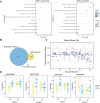Respiratory infection- and asthma-prone, low vaccine responder children demonstrate distinct mononuclear cell DNA methylation pathways
- PMID: 38961479
- PMCID: PMC11223352
- DOI: 10.1186/s13148-024-01703-0
Respiratory infection- and asthma-prone, low vaccine responder children demonstrate distinct mononuclear cell DNA methylation pathways
Erratum in
-
Correction: Respiratory infection‑ and asthma‑prone, low vaccine responder children demonstrate distinct mononuclear cell DNA methylation pathways.Clin Epigenetics. 2025 Mar 28;17(1):53. doi: 10.1186/s13148-025-01848-6. Clin Epigenetics. 2025. PMID: 40156027 Free PMC article. No abstract available.
Abstract
Background: Infants with frequent viral and bacterial respiratory infections exhibit compromised immunity to routine immunizations. They are also more likely to develop chronic respiratory diseases in later childhood. This study investigated the feasibility of epigenetic profiling to reveal endotype-specific molecular pathways with potential for early identification and immuno-modulation. Peripheral blood mononuclear cells from respiratory infection allergy/asthma-prone (IAP) infants and non-infection allergy/asthma prone (NIAP) were retrospectively selected for genome-wide DNA methylation and single nucleotide polymorphism analysis. The IAP infants were enriched for the low vaccine responsiveness (LVR) phenotype (Fisher's exact p-value = 0.02).
Results: An endotype signature of 813 differentially methylated regions (DMRs) comprising 238 lead CpG associations (FDR < 0.05) emerged, implicating pathways related to asthma, mucin production, antigen presentation and inflammasome activation. Allelic variation explained only a minor portion of this signature. Stimulation of mononuclear cells with monophosphoryl lipid A (MPL), a TLR agonist, partially reversed this signature at a subset of CpGs, suggesting the potential for epigenetic remodeling.
Conclusions: This proof-of-concept study establishes a foundation for precision endotyping of IAP children and highlights the potential for immune modulation strategies using adjuvants for future investigation.
© 2024. The Author(s).
Conflict of interest statement
JL-S is a scientific advisor to Precion Inc. and TruDiagnostic Inc. OL and SvH are named inventors on patents related to vaccine adjuvants and human in vitro systems that model immune responses. Their laboratories have received a sponsored research agreement from GlaxoSmithKline (GSK). OL is a co-founder of
Figures


Update of
-
Respiratory Infection- and Asthma-prone, Low Vaccine Responder Children Demonstrate Distinct Mononuclear Cell DNA Methylation Pathways.Res Sq [Preprint]. 2024 Apr 3:rs.3.rs-4160354. doi: 10.21203/rs.3.rs-4160354/v1. Res Sq. 2024. Update in: Clin Epigenetics. 2024 Jul 3;16(1):85. doi: 10.1186/s13148-024-01703-0. PMID: 38645021 Free PMC article. Updated. Preprint.
References
-
- WHO. Neonatal Mortality Rate (SDG 3.2.2). In: The Global Strategy for Women's, Children's and Adolescents' Health (2016-2030). 2015.
MeSH terms
Grants and funding
LinkOut - more resources
Full Text Sources
Medical
Molecular Biology Databases
Research Materials

